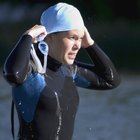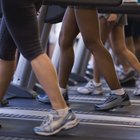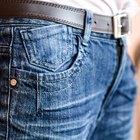
Chad McDermott/iStock/Getty Images
Swimming is a sport dominated by science. Competitors always are seeking ways to improve their performance in the water through the minimal equipment worn when racing. Most of this effort relates to reducing the amount of drag, or the resistance your body creates against the water.
Effects of Drag
Drag is produced by your body's friction against the water, which slows the body down with each stroke in the water. Even minimal amounts of drag catch against the water and serve to slow you down constantly throughout your swim. Your performance can be hindered by drag produced by everything from baggy swimming trunks to short hair follicles.
Types of Drag
Swimmers have to deal with three types of drag, according to Illumin: friction, pressure and wave drag. Frictional drag results from the constant rubbing against the water molecules by the swimmer's body, which slows forward motion. As the swimmer moves faster through the water, pressure drag starts to build; this type of drag develops at the swimmer's head, which often is leading the body through the water. This high pressure works in contrast to the pressure at the end of the body, which is much lower. The imbalance causes the swimmer to experience turbulence in the water, according to Illumin. Competitive swimmers competing in a race also can experience wave drag. Wave drag develops when a swimmer is moving quickly across the top of a body of water, creating waves. These waves cause imbalances in pressure on the body and can limit how fast a swimmer can move.
Reducing Drag
Reducing drag is a focus for most male and female competitive swimmers. Skin-tight clothing reduces your body's profile and keeps clothing from acting like a parachute in the water. Most competitive swimmers either wear a swimming cap over their hair or shave their head to minimize drag at the front of their body. Both male and female competitor swimmers usually shave the hair on their arms, legs and anywhere skin is in contact with the water, according to SoloSwims.com.
Drag Training
Minimizing drag is critical for races, but some swimmers prefer to train with equipment and features that create small amounts of drag. For example, they might practice without a swimming cap and without shaving to create resistance and increase the difficulty of the workout. When competition time approaches, they will switch to a minimal-drag approach and feel faster in the water. The best drag-reducing equipment is the product of a lot of research and development. Consequently, only professional swimmers are able to afford the most effective drag-reducing equipment available, but at lower levels of competition, races are not likely to be determined by thousandths of seconds the way professional and Olympic races sometimes are.
Related Articles

Why Should Men Shave Their Body?

Why Do Swimmers Wear Caps?

How Exercise Increases Hair Growth

The Advantages of Swim Caps

Skin Problems Caused by Swimming Pool ...

Summer Programs for Kids in Greeley, CO

Sunburn & Chlorine Pool Swimming

What Do You Wear for Gymnastic Practice?

Rash Guard for Swimming

Chemicals That Stop Testosterone ...

Types of Flat-Bottomed Boats

Amber Vs. Grey Sunglasses

What Kind of Jeans to Wear to Hide the ...

Does Yoga Reduce Cellulite?

The Importance of Teenage Friendships

What Does It Mean When Your Boyfriend ...

Is Acne Caused by Water Softeners?

Dry Suits vs. Wetsuits

Self Assessment of Conflict Management ...

The Difference Between Lee's Regular ...
References
Writer Bio
Jonathan Croswell has spent more than five years writing and editing for a number of newspapers and online publications, including the "Omaha World-Herald" and "New York Newsday." Croswell received a Bachelor of Arts degree in English from the University of Nebraska and is currently pursuing a Master's of Health and Exercise Science at Portland State University.
Photo Credits
Chad McDermott/iStock/Getty Images